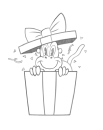Practice portraits anytime using our model packs and timer tool!
Why I Use Prismacolor
I like using a Prismacolor pencil because it’s permanent and not erasable. Once I put a line down, I have to leave it there. This helps me figure out what works and what doesn’t. When I do a drawing like this, especially for expressions, I like to do many versions instead of just one. I’ll draw them large enough to capture all the nuances, then scale them up or down later.
Setting Up the Head
I usually start by dividing the head into thirds. But because the mouth and jaw are opening, I extend the lower portion so the chin drops down further than usual. In this specific angle, the cheeks are pulled down, the zygomatic bones become more visible, and everything stretches over them. The hinge of the jaw stays in place while the chin itself moves lower. In a closeup reference, the lens might distort the perspective and push the ears back in space.
I always keep the ears visible. If the ears seem to disappear, it often means the shot is too close. I like to block in the large shapes: the side planes of the face, the forehead circle, and the overall head shape. This way, I know where the eyes, nose, and mouth should sit.
Getting the Proportions Right
I place the tear ducts first to control the spacing of the eyes. Then I check the overall rhythms across the face: the forehead lines, the main lines around the nose, and the laugh lines. If I don’t define the front and side planes early, features can drift and end up out of proportion.
As I work, I draw all over at once instead of focusing on one area. This lets me see if everything is matching up. I also note how skin folds develop around the corners of the eyes, nose, and mouth. For an angry expression, I push those folds and wrinkles to make them more dramatic.
Sharpening and Softening Edges
I hold the pencil differently, between my fingers, so I can use the tip for sharp lines and the side for broad shading. Prismacolor pencils are waxier and velvety, which gives me some pleasing soft transitions. I don’t want everything to be sharp, because that flattens the image. I reserve my sharper points for features like the eyes and the mouth, where I want the strongest clarity.
Building the Angry Expression
Anger shows up in furrowed brows, wrinkles across the nose, and tense muscles around the cheeks. The chin looks sharper because the skin is stretching. The mouth opens wider, and the corners pull outward. I make sure the upper teeth show under the lip, while the lower teeth and tongue drop with the jaw. I push the asymmetry in the lips if one side is raised higher than the other.
Communicating the Emotion
I aim for a wild energy in the hair, lifting it or flaring it out, to match the person’s anger. The lines around the eyes, nose, and brow should all work together. Even if it seems to age the person, those folds are essential to conveying the mood. I keep the pupils large to suggest a heightened and intense focus.
I prefer to use real-world reference whenever possible. Stock photos often give a best effort, but someone who’s genuinely angry or an actor who truly commits to the expression will reveal all those subtle cues you need. Illustration is acting, one single frame that should feel alive and authentic.
The Neck and Shoulders
I add the neck muscles, like the sternocleidomastoid and the platysma. When someone’s angry, their neck often tenses up and you see those lines more clearly. I trace the shirt line, and I show how the head dips into the shoulders. Everything should reinforce the anger, and nothing in the drawing should be calm if the mood is intense.
* * *
This kind of drawing is like note-taking for me. I record every fold, wrinkle, and plane so I thoroughly understand the expression. Later, I can take what I learned and commit it to a finished piece. The important thing is to remember that every part of the face contributes to the expression. I want the drawing to feel believable and explosive with anger, and that means pushing every line to match the emotion.
That’s how I approach capturing anger in a portrait: start big, note the major planes, push the expression as far as it needs to go, and draw all over rather than focusing on details too early. By the time I finalize the features, the entire head and neck will convey that single, powerful emotion.
Practice portraits anytime using our model packs and timer tool!


